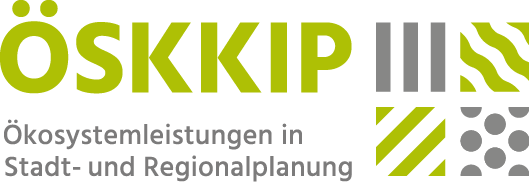Integration of ecosystem services in urban and regional planning
The OESKKIP acronym in German stands for “Ecosystem Services of Urban Regions – Mapping, Communicating, and Integrating into Planning to conserve biodiversity during a changing climate” (in German: „Ökosystemleistungen von Stadtregionen – Kartieren, Kommunizieren und Integrieren in die Planung zum Schutz der biologischen Vielfalt im Klimawandel“). The OESKKIP project tests the integration capacity of the ecosystem service (ES) approach into urban and regional planning. Facing climate change, the preservation of biodiversity in urban regions should be improved concurrently under changing conditions.
Biodiversity and ecosystem functions serve as a basis for ecosystem services. ES are differentiated in provisioning services for society such as provision of food and drinking water, in regulating services such as regulation of micro-climates or water quality and in cultural services that provide for aesthetic perceptions of the landscape or for leisure activities. The concept of ES enables a holistic perspective on the manifold relationships between ecosystems and society. However, in the current planning practice, ES are rarely really integrated into decision-making processes. Thus, the core of the joint research project is the communication and implementation of the ES concept into spatial planning and governance processes. ES are exemplary assessed in the urban regions Rostock and Munich as well as in selected surrounding smaller cities. This is realised by using existing data as well as participatory spatial surveys and assessments. Impacts of climate change on the supply of ES and biodiversity are outlined. By developing communication instruments, the potentials for improved transdisciplinary and interdisciplinary cooperation, for urban-rural cooperations as well as for an increased societal value of ES and biodiversity are assessed.
The results will lead to concrete recommendations for spatial planning practices on how to integrate ES. These recommendations contain target-oriented communication and participation strategies as well as survey and assessment approaches. By doing this, OESKKIP will contribute to the preservation of biodiversity in urban regions.
Project aims
The primary objective is to analyse potentials to implement the ES-approach into formal and informal urban and regional planning instruments while at the same time strengthening the protection of biodiversity – meaning diversity of habitats and species – in urban regions under changing climate conditions. In order to do so, the projects collects information as well as analyses urban ES according to target 2 / measure 5 of the European Biodiversity Strategy. The sampled information on the different ES will be available for spatial planning practices as well as for further processes of urban and regional development. Besides gathering and assessing ES in city-hinterland regions, ES will be communicated in participatory processes and implemented in current urban and regional planning instruments and procedures as well as in urban and regional governance processes.
The sub-projects have the following objectives:
Assessing current formal and informal planning instruments and procedures for their implementation capabilities of the ES-concept
Adapting the ES-approach to the requirements of decision makers
Communicating the interrelations between the well-being of society and endangered ecosystems as well as biodiversity, and communicating the related uncertainties, also within the climate-change context with potential not yet known impacts
Integrating ES into a transdisciplinary science-praxis-cooperation
Analysing the participatory assessment of ES as option for an integrated monitoring
Analysing the capability to optimise the cooperation between different administrative planning departments and authorities by implementing the ES-concept
Developing exemplary approaches and concrete recommendations to integrate the ES-approach into the urban and regional planning practices in Germany
Initiating and further developing interconnections and governance processes for the protection of bio-diversity in the pilot urban regions of Munich and Rostock with a distinct focus on city-hinterland-cooperations
Project Structure
The project is divided into five sub-projects (see figure), that work together in an interdisciplinary cooperation among three associated partners (HafenCity University Hamburg, ifuplan Munich, Leibniz Universität Hannover).
Sub-projects 1 and 2 form the research basis by analysing the integration capacity of the ecosystem services (ES) approach into urban and regional planning instruments and procedures as well as governance processes. Sub-project 3 deals with the connectivity and communication of the ES-concept in the context of public relations. Methods are needed to assess and evaluate these services for the practical implementation, which is done in sub-project 4. Sub-project 5 provides a link between science and practical application through consecutive workshops and a simulation process.
The cooperation between science and practical implementation enables interdisciplinary development, assessment and communication of approaches to integrate the ES-concept in urban and regional planning procedures and test those against the backdrop of the federal level respectively.
Ecosystem services (ES) in urban regions
Sub-project 1 investigates existing assessment and estimation methods of urban ES and exemplarily presents the application of the ES approach for the pilot urban regions Munich and Rostock. A key element is the further development of suitable indicators for the quantification of supply and demand of ES in urban ecosystems. With the "ES matrix" method, different spatial units and land use functions can be linked with biodiversity, ecosystem functions and ES. In addition, the effects of climate and land-use change on the capacity and provision of ES for the pilot urban regions will be simulated and analysed. In order to be able to integrate the ES-approach into urban and regional planning, the integration into urban and regional planning instruments as well as procedures is analysed. In summary, sub-project 1 provides the methodological and knowledge foundation and also the spatial representation of the results that are applied in the other subprojects.
Ecosystem services (ES) in urban regions
Sub-project 1 investigates existing assessment and estimation methods of urban ES and exemplarily presents the application of the ES approach for the pilot urban regions Munich and Rostock. A key element is the further development of suitable indicators for the quantification of supply and demand of ES in urban ecosystems. With the "ES matrix" method, different spatial units and land use functions can be linked with biodiversity, ecosystem functions and ES. In addition, the effects of climate and land-use change on the capacity and provision of ES for the pilot urban regions will be simulated and analysed. In order to be able to integrate the ES-approach into urban and regional planning, the integration into urban and regional planning instruments as well as procedures is analysed. In summary, sub-project 1 provides the methodological and knowledge foundation and also the spatial representation of the results that are applied in the other subprojects.
Team and Contact
HafenCity University HamburgResearch Partner
Global Change & Land Use Strategies | Henning-Voscherau-Platz 1 | 20457 Hamburg
Konrad Gray MSc. Sustainability Sciences
Coordination SP 2, 4, 5



